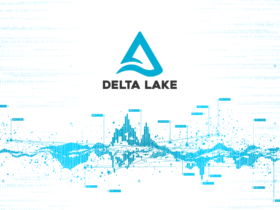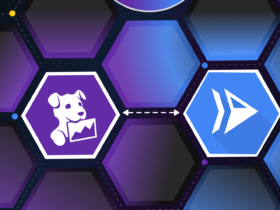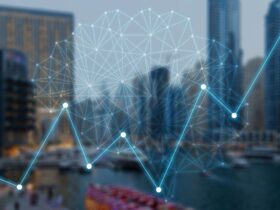
Data Fabric Architecture and components
As data creation grows year on year across organizations with an increase in the number of business systems, on-premises and cloud databases, and applications, all hosting data, they need to have an architecture to manage data across systems becomes more imperative for organizations.
A Data Fabric creates a virtualization layer by using APIs and integration tools to ensure data access and availability are possible across the organization. It pulls data from multiple systems, databases, apps and focuses on data movement, transformation, and synchronization.
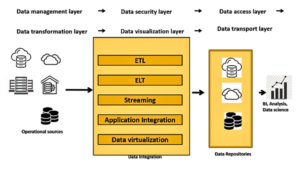
Seven Layers of Data Fabric:
Data management layer:
Every business system, whether it is your Enterprise Resource Planning software or customer Relationship Management/Customer Experience software, has a database that could be hosted on Azure, AWS, or another database. Additionally, you will have structured and unstructured data in multiple cloud and/or on- premises environments. In this layer, the important thing is to first identify data sources for ingestion and then have processes for deduplication, compression, migration, and tiering.
Data security layer:
While integration makes data accessible, there needs to be data protection practices and rules in place to ensure security. There needs to be a way to secure and back up all data. In the case of older information, there need to be methods to archive data. And when there is a breach or a data loss, then data recovery practices need to be carried out.
Data access layer:
This layer makes data available based on the security rules and processes in place in the previous layer. Using APIs and integration tools, your teams can access data across diverse data sources from the cloud to data lakes. This layer makes it possible for querying, updating, deleting, sharing, or moving data.
Data transformation layer:
As data that is ingested in the first layer could be in a structured, unstructured format or somewhere in the middle, to make sense of that data, data transformation is important. Implementing data processes that can transform, sort, and clean that data into a coherent format is what comes next. This will help people to then establish relationships between the various data sources in an organization.
Data visualization layer:
Before data can be analysed, data needs to be cleaned and monitored with data governance practices in place. Advanced technologies such as Artificial Intelligence and Machine Learning (AI & ML) to build dashboards can be set up for data monitoring and visualization. This will help you with data preparation and visualization which will make it easier to derive valuable business insights from your extracted data.
Data transport layer:
This layer establishes practices for data movement across the fabric to ensure no duplication, no disruptions in business, and compression wherever needed. These practices ensure that the data fabric is in motion without any issues or security risks.
Hosting the data fabric and monitoring your integrations:
Although this is external to the data fabric architecture, it is an important component. The data fabric can be hosted on the cloud or on-premises, as long as the data integration is possible between your architectural landscape and business systems and information is easily synchronized without any data silos.
Data fabric can also be hosted in a hybrid cloud or multi-cloud environment. Besides hosting the data fabric, monitoring your integrations is also an important element of strengthening your data fabric after it has been orchestrated.
Applications of Data Fabric
Data Fabric is a concept used to describe an architecture that enables organizations to manage and integrate data across various sources and locations.
Data Integration and Transformation: Data Fabric helps in integrating data from multiple sources, such as databases, cloud services, and APIs, and transforming it into a unified format for analysis and decision-making.
Data Sharing and Collaboration: Organizations can securely share and collaborate on data across departments, teams, and even with external partners while maintaining control over access and permissions.
Real-time Analytics: Data Fabric enables real-time data processing and analytics, allowing businesses to make informed decisions quickly based on up-to-date information.
Data Governance and Compliance: It helps enforce data governance policies and regulatory compliance by providing a centralized framework for managing data quality, privacy, and security.
Hybrid and Multi-Cloud Environments: Data Fabric supports seamless data movement and synchronization across on-premises and multiple cloud environments, improving data mobility and flexibility.
IoT Data Management: With the growth of the Internet of Things (IoT), data fabric can manage and process massive volumes of data generated by connected devices.
Master Data Management (MDM): Data Fabric assists in creating and managing a single, reliable source of truth for critical data, ensuring consistency and accuracy across the organization.
Machine Learning and AI: It provides a foundation for machine learning and AI initiatives by offering access to diverse and high-quality data for model training and validation.
Customer 360 View: Data Fabric helps create a holistic view of customers by integrating and analysing data from various touchpoints, leading to improved customer experiences.
Supply Chain Optimization: Organizations can leverage data fabric to monitor and optimize their supply chains by analysing data related to inventory, logistics, and demand.
Data Migration and Replication: Data Fabric simplifies the process of migrating data between different systems and environments while maintaining data integrity.
Event-Driven Architecture: It supports event-driven applications by facilitating the processing of real-time events and messages from various sources.
Data Virtualization
Data Fabric allows virtualization of data across different sources, making it appear as if it resides in a single location, which simplifies data access for applications. These use cases highlight the versatility of data fabric in addressing various data management and integration challenges faced by modern organizations
Before data can be analyzed, data needs to be cleaned and monitored with data governance practices in place. Advanced technologies such as Artificial Intelligence and Machine Learning (AI & ML) to build dashboards can be set up for data monitoring and visualization.
This will help you with data preparation and visualization which will make it easier to derive valuable business insights from your extracted data.
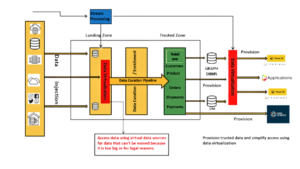
Future of Data Fabric
The future of Data Fabric is exciting, with new technologies and trends set to impact its development. One of the key areas of growth will be in the use of artificial intelligence (AI) and machine learning (ML) to help organizations better manage their data. These technologies will enable data fabric to automatically identify patterns and trends in large datasets, making it easier for businesses to make informed decisions based on real-time insights.
Another area of growth will be in the use of block chain technology to enhance data security and privacy. By using a distributed ledger system, data fabric can ensure that data is encrypted and protected from unauthorized access. This will be particularly important as more organizations move towards cloud-based data storage solutions.
Data Fabric Vendors
There are multiple vendors that deliver an integrated set of capabilities to support the data fabric architecture. In conclusion Data Fabric is an emerging concept, and learning how to implement it can be a monolithic undertaking, especially without knowledge of where to start. The Next Step in the Evolution of Data Architectures is a great place to begin learning what is needed to implement a successful data fabric architecture. As discussed, how data fabric is different from traditional data technologies like data warehouses and data lakes and answers burning questions such as how data fabric works with existing frameworks instead of replacing them and how you can leverage your pre-existing tools to start building your data fabric solution.
In conclusion Data Fabric is an emerging concept, and learning how to implement it can be a monolithic undertaking, especially without knowledge of where to start. The Next Step in the Evolution of Data Architectures is a great place to begin learning what is needed to implement a successful data fabric architecture. As discussed, how data fabric is different from traditional data technologies like data warehouses and data lakes and answers burning questions such as how data fabric works with existing frameworks instead of replacing them and how you can leverage your pre-existing tools to start building your data fabric solution.
Data Fabric is rapidly becoming the future of data and the foundation of a unified data solution. Learning how and why this is the case is essential to the growth of any modern enterprise, but you do not have to handle this task alone. Data Fabric provides an advanced approach to fabric by providing an all-in-one tool for integration that can manage real-time data, helping you reach your data fabric goals quickly.


